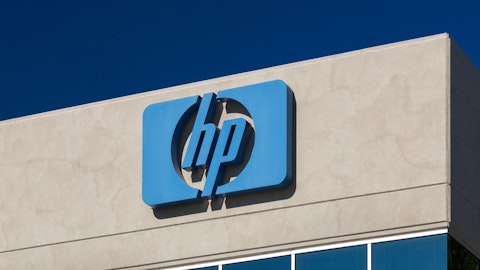Back in 1939, long before Steve Jobs, there were two guys in Palo Alto, Bill Hewlett and David Packard. Armed with less than $600, they started a small electronics testing company.
Over the next 70+ years, Hewlett-Packard grew into one of the world’s largest technology firms with over $100 billion in annual sales.
Last November, the current HP Inc (NYSE:HPQ) was created as one of two successors of Hewlett-Packard (the other half is HP Enterprises).
The idea was to take the mature HP Inc. operations and create a cash-generating, dividend-paying machine with leaner operations.
For income investors, HP has been a reliable dividend-paying stock for over 25 years and increased its payout for 6 consecutive years.
Furthermore, the stock offers an above-average 3.2% dividend yield and has seen its dividend compound by 9.4% per year over the last decade.
Higher-yielding dividend stocks usually do not record this strong of dividend growth, but HPQ could be an exception if things go right. Many of the most important financial ratios I analyze (see them all here) also look encouraging.
Furthermore, HPQ’s stock trades at a rather modest 9x estimated earnings. Let’s take a closer look at the company and whether or not it offers safe, growing dividend income or could be a value trap as the world of technology evolves.
Business Description
Hewlett-Packard was founded 77 years ago. In November of last year, the mother ship was split in two based on end user markets: HP Enterprise and HP Inc.
Hewlett-Packard’s $103 billion in revenue was split almost equally between the two businesses.
HP Inc., which trades under the ticker symbol HPQ and is analyzed in this article, consists of the company’s personal computer (PC) and printer businesses.
PCs and other personal systems account for roughly 63% of sales (1) and close to 30% of operating profit. The segment generates 3-4% operating margins.
The printer business accounts for the remaining 37% of revenue and roughly 70% of operating profit. The segment generates 18-20% operating margins.
HP’s total revenue breaks down as follows: notebooks 36%, print supplies 24%, desktops 21%, printer hardware 13%, workstations and other personal systems 6%.
By geography, roughly 49% of revenue is from the Americas with another 32% from EMEA and 19% from Asia.
HP products get to market in two ways. A vast network of channel partners provides service to most commercial customers. In addition, sales are made directly to big box store accounts like Best Buy Co Inc (NYSE:BBY), Staples, Inc. (NASDAQ:SPLS), and Office Depot Inc (NASDAQ:ODP).
Business Analysis
Over the course of many decades, HP has built up number one or two market share positions in all of its core markets, which total over $400 billion in size.
Replicating the company’s broad lineup of products, intellectual property, and distribution network for more than 250,000 channel partners would be extremely costly.
However, HP products still live in an intensively competitive world. Technology rapidly changes, product lifecycles are short, and commodity-type profitability is the norm as differentiation is difficult.
The company’s massive distribution network serves as an advantage, but the global PC market is in a mature, declining phase.
Desktops transitioned to laptops and are not morphing into ever-smaller, more mobile devices.
International Data Corp (IDC) reports (2) global shipments continue to slip, including a 4.5% drop during the second quarter of 2016.
HP’s leading share in the U.S. market is constantly being challenged by archrival Dell and a number of low-cost foreign competitors as well.
HP’s strategy is to redesign and reposition PC products at higher price levels to compete with hip and slick laptops like the MacBook.
However, profits are still difficult to come by even despite HP’s status as a market leader. As previously mentioned, HP’s PC segment earns 3-4% profit margins.
Mature market conditions are present in other HPQ product groups as well. Just take a look at the steady decline in the Printing segment’s revenue below.
The segment is still a cash cow thanks to its high-margin ink cartridges, but the sales trend is concerning. Management is trying to move into the $55 billion copier market, but the economics of this industry are also challenging.

Source: HP Investor Presentation (3)
Decaying revenue trends has pushed management to cut costs aggressively.
In connection with the separation of Hewlett-Packard into two companies in late 2015, HP’s board announced a major restructuring plan calling for the elimination of more than 30,000 jobs.
For now, HP’s leading market positions and mature operations will continue generating excellent free cash flow.
However, the company will eventually need to figure out how to restore profitable growth across the enterprise.
Follow Hp Inc (NYSE:HPQ)
Follow Hp Inc (NYSE:HPQ)



